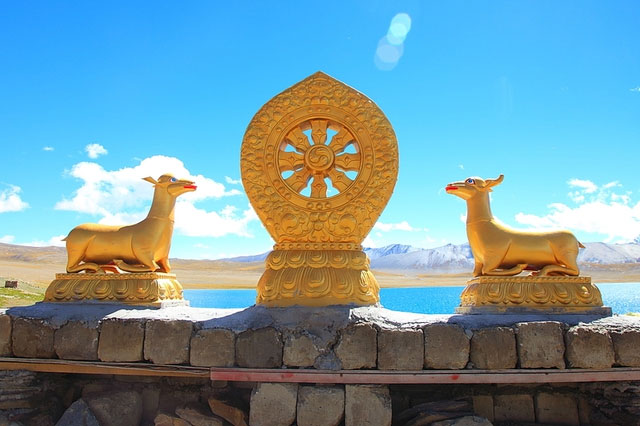The village is harsh, the oxygen level is extremely low, but why does no one want to leave?
Tibet is located on the Qinghai-Tibet Plateau, which is over 4,000 meters above sea level. Therefore, not everyone can adapt to the climate conditions in Tibet.
However, Tibet is considered a pure land of China, where many people come to purify their souls, as well as admire the many famous sights here.

Tibet is famous as the pure land of China. (Photo: Greattibettour).
Among the famous places in Tibet, there is a village famous for its harsh living conditions called Tuiwa . The village is located at the foot of Mongda Kangri Mountain, near the shore of Pumoyongcua Lake, with an altitude of up to 5,070m . Tuiwa is also the highest village in the world. Summer in Tuiwa lasts only more than 2 months. In particular, the amount of oxygen in the air here is less than half that of other places.

Tuiwa Village is located at an altitude of 5,070m above sea level, so it is very close to the Sun. (Photo: Xinhua).
Tuiwa means 'connection' in Tibetan. However, the village is not completely connected to the outside world, but is instead isolated from it. Transportation in this village is also inconvenient and living conditions are very harsh.
With an altitude of more than 5,000m above sea level, it is not easy for people to live there permanently. The population in the village is not large, with only a few hundred people. In particular, the people in the village depend entirely on agriculture and livestock.
Before 2015, there were no more than 100 tourists visiting Tuiwa village each year.
With harsh living conditions and lack of oxygen, the average life expectancy of the villagers is under 50. The local government has arranged for them to move many times. However, many people still do not want to leave their homeland and choose to stay here.
Tuiwa village is located more than 5,000m above sea level and close to the sky, so visitors can see the stars at close range. This is also the special thing that many people look forward to the most when setting foot in Tibet.
In particular, weaving is a traditional occupation in Tuiwa village. Therefore, visitors can easily see weaving looms in the houses of the locals here. In addition, because the people in Tuiwa live in harmony with nature and do not destroy the ecological environment, the beautiful scenery around the village remains almost intact.

People in Tuiwa village have a simple and peaceful life. (Photo: Greattibettour).
The people here live a simple, ordinary life. Every day, the young people in the village go to the fields to graze their cattle. Instead, only a few children and the elderly stay behind to look after the houses. This makes the village even more quiet. If Tuiwa were not at an altitude of over 5,000m, this village would be a good resort for the holidays.
During the coldest days of winter, the villagers of Tuiwa herd their sheep onto an island in the center of Lake Puma Yumco . Strangely enough, while the pastures near Tuiwa wither during the dry season, the grass on this island flourishes. During the winter, Lake Puma Yumco is covered with a thick layer of ice, allowing the villagers to herd their sheep across the lake.

Tuiwa villagers live mainly by raising livestock. (Photo: QQ).
After the dry season ends, villagers will bring their sheep back before the ice melts. This is a tradition that has existed in this land for thousands of years.
In addition to grazing cattle, Tuiwa villagers also come to spin prayer wheels in the temple to pray. Every spring, villagers hold a Kora ceremony around Puma Yumco Lake, and then burn incense in the temple to pray for blessings.
When the New Year comes, the Tuiwa villagers will often cook lamb. This is one of their long-standing traditional dishes.
Due to its high altitude, the population here is sparse. Tuiwa Village currently has less than 200 people. The villagers still maintain almost primitive living conditions. They maintain a system of taking turns raising livestock together, dividing them equally. Even the candy brought by tourists for children will be divided according to the number of people in each household.
How does altitude affect the human body?

People in Tuiwa have an average life expectancy of less than 50 due to harsh living conditions and lack of oxygen. (Photo: QQ).
According to experts, when the atmosphere is at sea level, the human lungs and circulatory system are optimized to function normally. However, as humans go to higher altitudes, the air pressure also decreases. Because the air becomes thinner and has less oxygen, the human lungs will also have difficulty breathing.
When reaching an altitude of 2,500m, some people also experience mild symptoms of hypoxia to the brain. This causes the breathing process to become rapid, and the heart rate also increases to provide oxygen to the body's organs.
In particular, the above problems and symptoms will become increasingly serious when people reach an altitude of 5,500 m. At that time, the oxygen in the air is only half the amount of oxygen at sea level.
According to experts, when reaching the " Death Zone", an area with an altitude of more than 7,600m in the atmosphere, humans cannot survive for long due to the lack of air in the thin air. This is also the reason why climbers often get altitude sickness when going to this area.
- Visit the village cold -71 degrees Celsius
- Why does the amount of oxygen in the Earth's atmosphere need to maintain a level of 20.9%?
- Too much oxygen is not conducive to children!
- Interesting secrets about oxygen
- Oxygen appeared early on Earth
- Structure and working principle of oxygen generator
- The unique villages in the world
- Mysteriously the village is sinking into the sea
- 15 villages as beautiful as fairy tales
- Where does the oxygen for the oxygen mask really come from?
- Ocean exhausted oxygen at record level, alarming a series of 'dead zones'
- Smart people get sick less than others
 'Fine laughs' - Scary and painful torture in ancient times
'Fine laughs' - Scary and painful torture in ancient times The sequence of numbers 142857 of the Egyptian pyramids is known as the strangest number in the world - Why?
The sequence of numbers 142857 of the Egyptian pyramids is known as the strangest number in the world - Why? History of the iron
History of the iron What is alum?
What is alum?